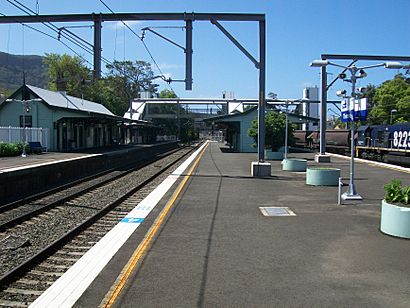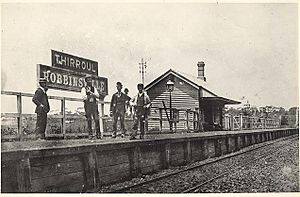Thirroul railway station facts for kids
Quick facts for kids
Thirroul
|
||||||||||||||||
|---|---|---|---|---|---|---|---|---|---|---|---|---|---|---|---|---|

Northbound view from Platform 2 in January 2008
|
||||||||||||||||
| Location | Railway Parade, Thirroul Australia |
|||||||||||||||
| Coordinates | 34°19′05″S 150°55′08″E / 34.318048°S 150.918911°E | |||||||||||||||
| Elevation | 47 feet (14 m) | |||||||||||||||
| Owned by | Transport Asset Holding Entity | |||||||||||||||
| Operated by | NSW TrainLink | |||||||||||||||
| Line(s) | South Coast | |||||||||||||||
| Distance | 70.24 kilometres from Central | |||||||||||||||
| Platforms | 3 (1 side, 1 island) | |||||||||||||||
| Tracks | 4 | |||||||||||||||
| Connections | Bus | |||||||||||||||
| Construction | ||||||||||||||||
| Structure type | Ground | |||||||||||||||
| Disabled access | Yes | |||||||||||||||
| Other information | ||||||||||||||||
| Station code | TRL | |||||||||||||||
| Website | Transport for NSW | |||||||||||||||
| History | ||||||||||||||||
| Opened | 21 June 1887 | |||||||||||||||
| Electrified | Yes | |||||||||||||||
| Previous names | Robbinsville | |||||||||||||||
| Traffic | ||||||||||||||||
| Passengers (2013) | 1,360 (daily) (Sydney Trains, NSW TrainLink) | |||||||||||||||
| Rank | 143 | |||||||||||||||
| Services | ||||||||||||||||
|
||||||||||||||||
Thirroul railway station is a train station in Thirroul, a suburb north of Wollongong in New South Wales, Australia. It's an important stop on the South Coast railway line. This station is also listed on the New South Wales State Heritage Register, which means it's a special historical place.
Contents
A Look Back: History of Thirroul Station
When people first started settling in this area in the 1870s, the whole region north of Wollongong was known as Bulli. Thirroul itself was called North Bulli. Before European settlement, the land belonged to the Thurrural tribe. Their name, which has many spellings, means "the place or valley of the cabbage tree palms."
The village of Thirroul was once called Robbinsville. This name came from Frederick Robbins, who owned land in the area. The community decided on the name Robbinsville in February 1880. Later, Thirroul became a popular place for tourists, especially for surfing. Many people from Sydney built holiday homes near the ocean here.
The railway line, called the Illawarra Railway, was built in sections. An early part of the line opened on 21 June 1887, connecting places like Stanwell Park to Yallah. Thirroul station opened on this date, and it was first known as Robbinsville. It had a small timber building and a timber platform. In November 1891, the station's name was changed to Thirroul. The entire railway line finally connected to Sydney on 3 October 1888.
Over the years, the station changed a lot. In 1915, the railway line from Scarborough to Thirroul was made into two tracks (duplicated). This meant a new platform was built. A large timber building was moved from Scarborough to Thirroul's Platform 1. This building had waiting rooms, a ladies' room, and a ticket office. The original building on Platform 2/3 was also changed in 1939 to become an island platform.
In 1921, a special building for railway workers, called the railway institute, was built. It was made bigger in 1937. By 1941, Thirroul was a major spot for trains, with facilities like an oil store, coal bunker, and a turntable to turn trains around. In 1986, the railway line was electrified, meaning trains could run on electricity.
More recently, in 2005, the old footbridge was replaced. A new concrete footbridge with lifts and stairs was added, making it easier for everyone to access the platforms.
Platforms and Train Services
Thirroul station has three platforms. One is a "side platform" (Platform 1), and the other is an "island platform" (Platforms 2 and 3) with tracks on both sides.
Trains from Thirroul are operated by NSW TrainLink. You can catch trains going to:
- Sydney Central
- Bondi Junction
- Kiama
- Port Kembla (some trains end their journey here)
- Waterfall (for local services)
| Platform | Line | Stopping pattern | Notes |
| 1 |
NSW TrainLink
|
services to Central & Bondi Junction | |
|---|---|---|---|
| 2 |
NSW TrainLink
|
services to Port Kembla & Kiama | |
| 3 |
NSW TrainLink
|
services to Port Kembla |
Getting Around: Transport Links
Besides trains, you can also catch buses from Thirroul station.
- Dion's Bus Service runs two routes:
- Route 90: From Austinmer to Wollongong
- Route 91: From Austinmer to the University of Wollongong
- Premier Charters runs one route:
- Route 2: From Stanwell Park to Wollongong
What the Station Looks Like
Thirroul station has several important buildings and features. These include the main station buildings, the old Railway Institute building, and the platforms themselves. The station is located between Station Street and Railway Parade. You can enter from the west through a park or from Station Street on the east using a modern footbridge with lifts and stairs.
Platform 1 Building
This building is made of weatherboard (timber planks). It has a roof that sticks out over the platform, supported by steel brackets. The roof is made of corrugated steel. The building has a complex roof shape with pointed ends (gables). There are two brick chimneys. Inside, you'll find waiting rooms, offices, and toilets.
Platform 2/3 Building
This is also a single-storey weatherboard building with a corrugated steel roof. It has roofs that stick out over both sides of the platform, supported by steel brackets. This building is believed to be the original station building, but it was changed and extended in 1915 and again in 1939. It also contains waiting rooms and offices.
Thirroul Railway Institute Building
This separate building, built in 1921, is located at the south end of Platform 1. It's made of weatherboard and fibro (a type of building material). It has a pointed roof and a small entry porch. The building has timber walls up to the windows, with fibro above. It features double-hung windows.
Other Features
- Former Toilets: Next to the railway institute is a small, old toilet building with a pointed roof.
- Platforms: Both platforms have brick edges with concrete tops and asphalt surfaces.
- Footbridge, Steps, and Lifts: A modern covered footbridge with stairs and lifts was added in 2005, making it easy to move between platforms.
- Platform Canopies: Modern roofs on steel posts connect the platform buildings to the footbridge, providing shelter.
- Views: From the platforms, you can see beautiful views of the Illawarra escarpment, which is a steep slope of mountains.
Changes Over Time
The station has been updated many times:
- 1915: The building on Platform 1 was moved from Scarborough, and the Platform 2/3 building was changed.
- 1921: The Railway Institute building was constructed.
- 1937: The Railway Institute building was made larger.
- 1939: Platform 2/3 was changed to an island platform.
- 1941: The station became a major train depot with many facilities.
- 1986: The railway line was electrified.
- 2005: A new footbridge, stairs, and lifts were installed.
Why Thirroul Station is Special: Heritage Listing
Thirroul Railway Station is considered very important to the history and culture of New South Wales. This is why it's on the New South Wales State Heritage Register.
- Historical Importance: The station shows how the railway line was built in two main stages: the first in 1887 and then when it was made into two tracks in 1915. It has been a key transport hub for Thirroul since 1887. It also played a big part in Thirroul becoming a popular seaside holiday spot in the late 1800s and early 1900s. The station was also a major place for train maintenance, which you can see from the old Railway Institute building.
- Design and Appearance: The station buildings are good examples of early railway architecture, even though they were changed a lot in 1915. The Railway Institute building is quite rare, as there are not many like it left in New South Wales.
- Community Connection: The old Railway Institute building is still used by the Thirroul Railway Institute Preservation Society. This shows how important the building is to the local community.
- Rarity: The Railway Institute building is very rare, with only a few other examples existing in the NSW railway network. The Platform 1 building is also one of only four timber platform buildings of its kind left on the Illawarra line.


